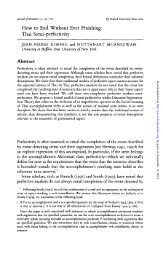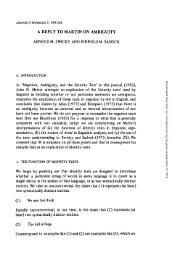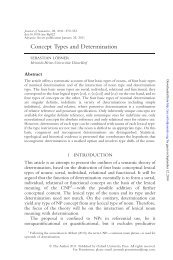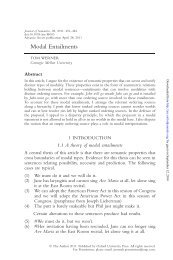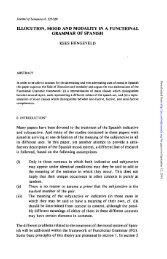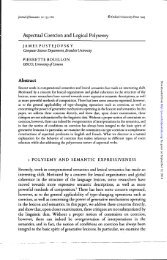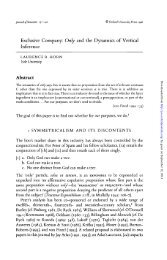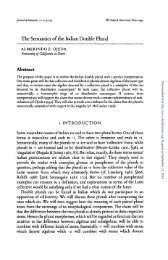Lexical Pragmatics - Journal of Semantics
Lexical Pragmatics - Journal of Semantics
Lexical Pragmatics - Journal of Semantics
Create successful ePaper yourself
Turn your PDF publications into a flip-book with our unique Google optimized e-Paper software.
Reinhard Blutner 125the structure <strong>of</strong> the (mental) lexicon may be derived. As an example for thiskind <strong>of</strong> research I refer to seminal work <strong>of</strong> Caramazza & Grober (1977).These authors investigated twenty-six senses <strong>of</strong> the word line. Clusteringand scaling analyses revealed five major groupings <strong>of</strong> these senses for whichclear descriptions can be given. Distinguishing a core meaning level fromthe level <strong>of</strong> conceptually salient senses, Caramazza & Grober have proposedEXTENSION as the underlying abstract core meaning <strong>of</strong> line and they havepresumed 'instruction rules' <strong>of</strong> the form REALIZE X AS Y (where X and Ycorrespond to semantic representations) in order to produce the abstractmeanings <strong>of</strong> the five clusters. Thereafter, the application <strong>of</strong> subsequentinstructions produce the senses realized in specific contexts. As an example<strong>of</strong> how the instruction rules might work, Caramazza & Grober (1977)consider the derivation <strong>of</strong> the sense <strong>of</strong> line in draw a line under the title <strong>of</strong> thebook. The 'linguistic dictionary' correlates the sound part <strong>of</strong> line with its coremeaning EXTENSION. Using the instruction REALIZE EXTENSIONAS UNIDIMENSIONAL EXTENSION, an output corresponding to acertain cluster <strong>of</strong> concrete senses would be realized. Applying a furtherinstruction, say REALIZE UNIDIMENSIONAL EXTENSION AS VISUALPERCEPTIBLE, would help to isolate the intended surface sense.Though investigations <strong>of</strong> that kind may be extremely instructive andinteresting from a psycholinguistic point <strong>of</strong> view, they leave an importantpoint out <strong>of</strong> consideration: the isolated investigation <strong>of</strong> singular lexical unitscloses one's eyes to certain regularities and restricting conditions that mayarise alone from investigating the semantic relations between different butin some aspects similar lexical units.The lexicologist must show the relationships between all the senses <strong>of</strong> a lexical item (a taskwhich conventional dictionaries have done well) and also the relationships <strong>of</strong> related senses<strong>of</strong> different lexical items (a task which recently linguists have begun doing), but few studiesattempt to do both <strong>of</strong> these tasks (Lehrer 1978: 95).Following this methodological insight, Lehrer has investigated cookingwords (Lehrer 1968), temperature words (Lehrer 1970), and sensory wordsfor taste, smell, feel (Lehrer 1978), and she has suggested the followinghypothesis:Downloaded from http://jos.oxfordjournals.org/ by guest on September 12, 2014If there is a set <strong>of</strong> words that have semantic relationship in a semantic .field (where suchrelationships are described in terms <strong>of</strong> synonymy, autonymy, hyponymy, etc., and if one ormore items pattern in another semantic field, then the other items in the first field areavailable for extension to the second semantic field. Perceived similarity is not necessary(Lehrer 1978: 96).As a necessary condition on semantic transfer—the transfer <strong>of</strong> words with ameaning in one domain to another—this principle is certainly interesting.However, as Lehrer suggested herself, not each potential transfer <strong>of</strong>



